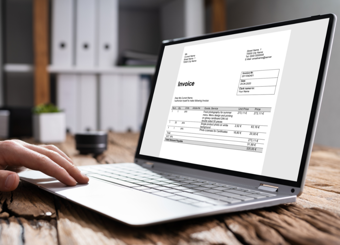3 hacks to simplify your accounts payable process flow
According to the 2019 AP Automation Benchmark Metrics report by Ardent Partners, 39% of surveyed companies reported lengthy approval times as the most common challenge in the AP department.
But accounts payable teams suffer from much more than just resource-heavy, manual tasks- and they need more than an AP procedures manual and an understanding of the accounts payable process flow chart to succeed. Without automation and optimization tools, AP teams lack visibility into the process and struggle to gather the data they need to close the books – every month.
Keep it simple
Finance managers and CFOs usually realize the need for AP transformation when they notice their team struggling to deliver what their organization needs to thrive, especially with regard to efficient invoice processing and timely reporting of financial metrics. In addition, the lack of visibility of the invoice process may mask issues with overall control, cash forecasting, and audits. Lastly, budget holders feel the pain of having to be on site to approve invoices, alternatively approving ad-hoc emails with invoices attached. There’s no trace or trail and no way to look into previous invoices or get a summary view of actual spend. It’s not uncommon for those spearheading their company’s AP transformation to find more challenges along the way. Finding - and fixing - these shortcomings, however, is key to creating a more efficient and effective financial department. Consider these three hacks to simplify your accounts payable process flow and set your organization on the path to true AP automation.
Hack #1: Use digital tools to reclaim control of your numbers
Implementing an accounts payable automation solution is not just about replacing manual, paper-based and broken processes with a workflow. One of the first benefits you’ll experience is that information that used to sit on people’s desks, inboxes, or worse, in unopened envelopes, is now available in digital format.
With an AP automation tool, all invoices currently in the workflow are tracked by the system and then stored in a digital archive. This gives the AP team first-hand access to the information they need to complete the month-end closing of books in a timely and accurate manner, based on the current accounts payable process flow chart.
Making your data more easily accessible enables the accounts payable team to increase their internal reputation and become a key player for the finance team, supporting them with real-time data for crucial financial reports. For example, AP’s data will improve the accuracy of cash flow forecasts by foreseeing upcoming payments of invoices that are currently in process and not yet in the ERP system.
Regaining control of invoice data also provides a means of fighting external and internal fraud attempts. Many AP solutions offer pre-packaged audit reports to support professional and painless finance, accounting, or IT audit processes, such as SOX compliance, ensuring processes are in place to protect the company from external fraud.
Companies that don’t have a handle on their numbers are also more at risk for committing fraud by accident (by submitting incorrect information), or failing to catch employees that are committing it through the company. In fact, ACFE’s 2020 Report to the Nations states that nearly one-third of all fraud cases are the result of a lack of internal controls - making it a leading area of organizational weakness.
Hack #2: Automate repetitive tasks
The most efficient way to perform a task is not doing it! This is particularly true for the accounts payable process. There are so many tasks that the AP team performs over and over again: invoice processing that includes coding a repeat invoice the same way each month, sending it to the same approver every time, or mapping it to a purchase order line by line.
These tasks (and many more) can be automated by an accounts payable automation solution, freeing up AP resources for more value added work. Start off by mapping out the current process and identifying which steps may be automated by applying business rules and logic in the system. This will look a bit different if you are handling order-based invoices or non-order-based invoices.
In many cases, the accounts payable process flow can be performed without any user intervention at all (so-called touchless invoice processing). This means that an order-based invoice is automatically connected to a pre-approved purchase order;when everything matches up, the invoice is sent directly to the ERP for final posting and payment. Benchmarks indicate that organizations using a modern AP automation solution reach, on average, a 68% touchless rate for order-based invoices, with best-in-class AP teams hitting over 97%.
Not all invoices will follow the touchless route, but there are still many great opportunities to automate parts of the process, such as automatic coding of invoices and sending to the right person for approval automatically, removing manual steps . When human intervention is needed for tasks including manual control of deviations or budget owner approval for an expense invoice, it’s important to have the tools and processes in place to perform those manual tasks as efficiently as possible.
Hack #3: Use process performance metrics
Once a digital, automated AP process is in place, it is crucial to closely measure and monitor AP performance by tracking a few key metrics. While there may be some variance depending on your business, there are four metric that every company should monitor:
- touchless rate for order-based invoices
- total processing lead time
- automatic approval forwarding rate
- manual approval time.
With these metrics at hand, organizations can establish a baseline and set realistic targets to achieve.
By using universal KPIs they can take advantage of industry benchmarks to compare their performance with similar companies, and explore which areas of their process offer room for improvement. Not only will this help the AP team to work with continuous efficiency improvements, but it will also prove to the rest of the organization that the AP function is a highly efficient one, driving important cost savings and creating positive effects on overall business results.
For larger organizations, process performance metrics are excellent tools for comparing different companies or divisions within the group with each other; in so doing, they can identify leaders and laggards, pinpoint issues, and support best practice sharing across the group, thereby increasing overall performance levels.






